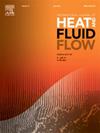利用广义 k-ω (GEKO) 湍流模型研究自由射流和撞击射流
IF 2.6
3区 工程技术
Q2 ENGINEERING, MECHANICAL
International Journal of Heat and Fluid Flow
Pub Date : 2024-11-26
DOI:10.1016/j.ijheatfluidflow.2024.109660
引用次数: 0
摘要
本数值研究侧重于新型广义 k-ω (GEKO) 湍流模型。该模型的独特之处在于自由模型参数 Cmix(混合)和 Cjet(射流)可调,适用于自由射流,而 Csep(分离)和 Cnw(近壁)则用于撞击射流。采用槽形和圆形自由射流和撞击射流来评估模型在多个流动方面的一致性。撞击表面为平板和圆柱体,工作流体为空气。研究了自由射流和撞击射流的速度、湍流强度、湍流粘度比和努塞尔特数等参数。自由参数的具体范围为:Cmix = 0.15-0.95,Cjet = 0-1,Csep = 0.7-2.5,Cnw = - 2-2。 Cmix = 0.2 用于圆形喷流,Cmix = 0.3-0.4 用于槽形喷流;Cjet = 0.9 和 Cnw = 0.5 用于两种喷流配置的数值结果与现有文献一致。槽形喷流的 Csep = 1.75 和圆形喷流的 Csep = 1-2.5 被认为是理想的数值预测值。GEKO 湍流模型提供了生产限制器的附加功能,可防止冲击射流停滞区的湍流增加。因此,在本研究中,数值传热预测比实验传热预测高出的比例被限制在 35%,而之前的研究报告称高达 300%。此外,还将 GEKO 湍流模型与高成本的大涡流模拟(LES)进行了比较,结果表明大涡流模拟具有出色的数值能力。本文章由计算机程序翻译,如有差异,请以英文原文为准。
Investigation of free and impinging jets using generalized k–ω (GEKO) turbulence model
The present numerical study focuses on a novel generalized k–ω (GEKO) turbulence model. The model has unique feature of tunable free model parameters Cmix (mixing) and Cjet (jet) applicable for free jets along with Csep (separation) and Cnw (near wall) used for impinging jets. The slot and circular free jets and impinging jets are employed to assess the model’s consistency in multiple flow aspects. The impinging surfaces are flat plate and cylinder and air is working fluid. Parameters such as velocity, turbulence intensity, turbulence viscosity ratio and Nusselt number are investigated for free and impinging jets. The free parameters have specific range where Cmix = 0.15–0.95, Cjet = 0–1, Csep = 0.7–2.5 and Cnw = − 2 to 2. The numerical results from Cmix = 0.2 for circular jet, Cmix = 0.3–0.4 for slot jet; Cjet = 0.9 and Cnw = 0.5 for both jet configurations are consistent with existing literature. Csep = 1.75 for slot jet whereas Csep = 1–2.5 for circular jet are considered as ideal for numerical prediction. The GEKO turbulence model offers additional feature of production limiter which prevents turbulence increment in stagnation region for impinging jets. Therefore in present study over prediction of numerical heat transfer than experimental is limited to 35 % whereas previous studies have reported it as high as 300 %. Moreover, the GEKO turbulence model is compared with high cost Large Eddy Simulation (LES) which shows excellent numerical competency with LES.
求助全文
通过发布文献求助,成功后即可免费获取论文全文。
去求助
来源期刊

International Journal of Heat and Fluid Flow
工程技术-工程:机械
CiteScore
5.00
自引率
7.70%
发文量
131
审稿时长
33 days
期刊介绍:
The International Journal of Heat and Fluid Flow welcomes high-quality original contributions on experimental, computational, and physical aspects of convective heat transfer and fluid dynamics relevant to engineering or the environment, including multiphase and microscale flows.
Papers reporting the application of these disciplines to design and development, with emphasis on new technological fields, are also welcomed. Some of these new fields include microscale electronic and mechanical systems; medical and biological systems; and thermal and flow control in both the internal and external environment.
 求助内容:
求助内容: 应助结果提醒方式:
应助结果提醒方式:


